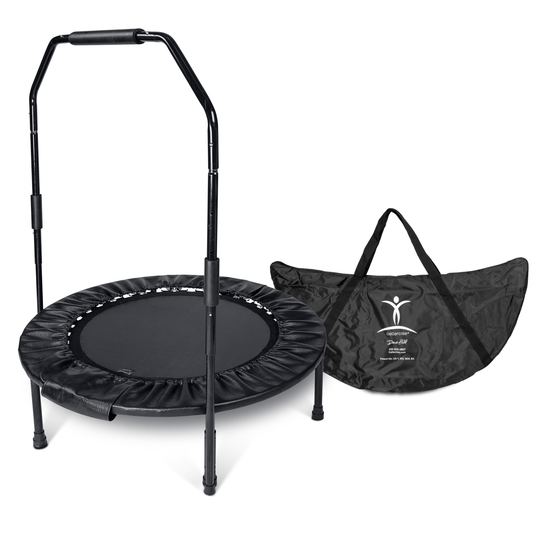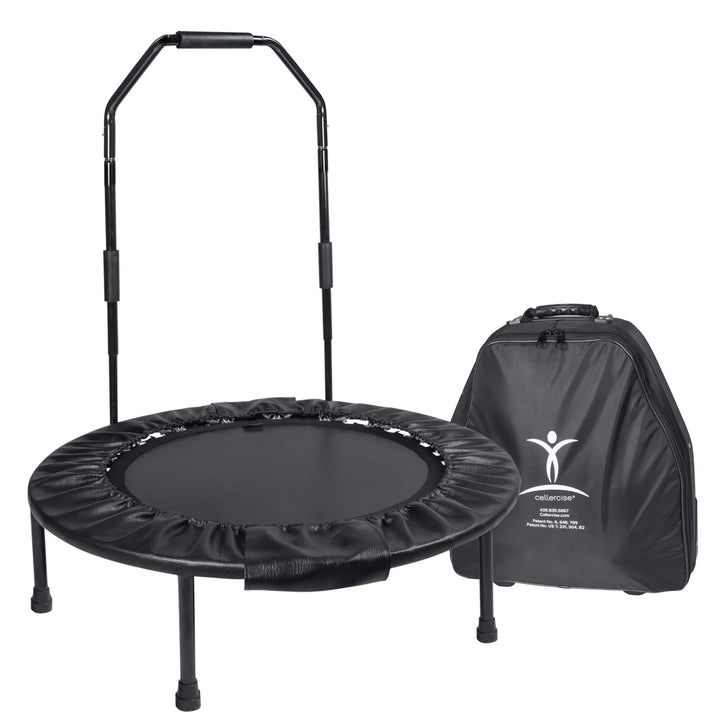Are Rebounding Exercises Good for You?
Disclaimer: This Blog/Web Site is made available by the publisher for educational purposes only as well as to give general information & understanding regarding the industry. It is not to be used as specific medical advice or to replace consulting with your doctor. You should always consult with your doctor. By using this Blog / Web Site you understand that this Blog/Web Site should not be used as a substitute for medical advice from a licensed professional. For our full disclaimer, please read: Cellercise® Disclaimer
Rebounding, or jumping up and down on a miniature trampoline, has become a very popular form of exercise over recent years. It’s easy to get started, simple enough that virtually anyone can do it and effective enough that anyone from any age group can benefit from exercising on a rebounder. But you might wonder, “is jumping on a mini trampoline good for you?”
It may seem like simple childish fun, but the reality is that your rebounder can offer a fantastic workout with a wide range of potential benefits, including toning various muscle groups of the lower body, increasing oxygen levels, and improving lymphatic system functions. If you’re wondering, “are rebounding exercises good for you,” the answer is yes.
Physical Benefits of Rebounding
Rebounding is a simple yet effective low impact aerobic exercise. Mini trampolines have a good amount of give to them, so you will need to activate various muscle groups to keep bouncing. Most people who start rebounding will notice toning in their calves, thighs, buttocks, back, and lower abdominal muscles. It’s also possible to switch up movements and target other muscle groups. For example, oblique twists are performed by jumping and rotating the hips one way and the shoulders another. This movement strengthens the abdominal muscles and can help slim the waistline. Different styles of bouncing can help you target specific muscle groups so you can have the workout you want.
Rebounding also strengthens the bones, joints, and connective tissues of the body. If you have struggled with high-intensity workouts in the past and want to limit your risk of injury, bouncing on your mini trampoline can improve the effectiveness of your other exercises and make it less likely that you will suffer an injury while exercising. Rebounding is also great for people who struggle with osteoporosis or other degenerative bone illnesses. The gentle impact of each bounce will help strengthen the bones and make joints more resilient.
David Hall, the owner of Cellercise®, has seen a tremendous number of positive physical effects among those who have tried the Cellercise® rebounder:
“Cellerciser® works to strengthen the efficiency of the body at the cellular level. When cells are stronger, healthier, and working more efficiently, the body as a whole will be, too. We have seen benefits of Cellerciser® use in people with all types of conditions and medical issues. Cellercise® can improve a person's performance in any athletic activity because it treats the body collectively as a whole."
“Cellercise® can improve balance dramatically because balance is not something we are born with, it’s something we learn over time, and balance can be improved at any age. Cellercise® workouts also massage the ligaments and tendons to increase circulation. The Cellercise® rebounder does not favor one side of the body over the other; it treats the body collectively to improve overall health, fitness, posture, and strength. Users can target different areas of the body to treat specific issues with digestion, the knees, hips, lungs, and stress. Cellercise® rebounding can also provide a natural facelift, promote better sleep, and so much more. I don’t know of any other exercise like it.”
Internal Benefits of Rebounding
If you’re still asking yourself, “is jumping on a mini trampoline good for you,” consider that rebounding offers many benefits that other exercises simply cannot match. The first example of this is lymphatic system activation. Your lymphatic system is responsible for collecting and removing waste materials and toxins from the body, including dead cells, bacteria, and excess lactic acid. Rebounding causes the fluids of your lymphatic system to flow more freely, increasing the effectiveness of the system and ridding your body of toxins at a faster pace.
Removing these toxins can boost your energy levels, help you fight disease, and improve your mood. Additionally, rebounding is an aerobic exercise that will increase your heart rate and help you burn calories. The best part is that it’s fun and easy to feel like you’re not working out as hard as you actually are. Many people who decide to try rebounding and stick with it are surprised at their results and how quickly they seem to manifest. This is psychological; if you hate running, it will probably take you a long time to appreciate your progress if you force yourself to run everyday. If you do an enjoyable exercise, you will probably work out harder than you realize every session and look forward to the next session.
Another internal benefit of rebounding is increased red bone marrow activity. Your red bone marrow generates white blood cells that travel throughout your body to fight invasive substances and quell infections. A higher white blood cell count means your body is more resilient and more resistant to illness. This can be especially beneficial for people struggling with cancer and other immune system disorders that diminish white blood cell counts.
Are There Any Risks to Rebounding?
Rebounding is accessible and easy for almost anyone to enjoy. However, like any other exercise, there is a slight risk of injury if you’re not careful. A few simple safety tips can help you prevent injuries while rebounding:
- Make sure the rebounder is situated on a flat, level surface away from any nearby objects. These could become hazards if you fall.
- Take it slow. You don’t need to bounce as high as you possibly can when you first start rebounding. Gentle bounces where your feet barely leave the surface of the trampoline can be highly effective, and you can increase your intensity over time.
- Speak to your doctor about rebounding. Make sure your doctor knows you want to start rebounding so you can discuss any potential complications or hazards.
- Pay attention while you rebound at first. While you may eventually want to work in a bit of TV time while you work out, pay attention to your rebounding exercises closely at first. This will help you acclimate to the bouncing motion and limit the risk of falling.
- Stop if you have any adverse reactions. Although rare, it is possible for some people to experience dizziness, headaches, or nausea when they begin a workout routine. If you notice any of these symptoms, stop bouncing immediately and talk to your doctor. It could be an isolated reaction or a symptom of a more serious underlying issue.
Rebounding is easy to work into an existing exercise routine as a warmup, cooldown, or both. It’s also easy to build a workout routine entirely out of rebounding exercises. Simple change up your motions every minute or so to target different muscle groups and work up a healthy sweat.
Medical research also supports rebounding as a viable form of exercise. In a study of 24 college students, researchers determined that rebounding sessions elevated heart rate and burned calories at a rate comparable to running, but participants enjoyed rebounding much more and felt less exertion during their rebounding sessions. Rebounding can be a great way for people who hate working out to work out effectively, burn calories, and tone various muscle groups in an enjoyable way.
If you’re still wondering “is jumping on a mini trampoline good for you?”, try it for yourself and see what kind of results await you after a few weeks of daily rebounding sessions. Readers should remember the contents of this article are meant to inform about the potential benefits of using the Cellercise® rebounder. This article is not medical advice, nor is it meant to treat any specific medical issue. Always consult your physician before starting any new workout routine, especially if you have specific health goals you wish to meet.
NOTE: Remember to always consult with your doctor or health professional before starting new exercise routines.
Get Your Cellerciser® and start rebounding today!














